Top News
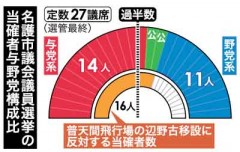
September 8, 2014 Ryukyu Shimpo
On September 7, the outcome of Nago City Council Election was released. The election drew national attention with candidates focusing on the for and against arguments of building a new base in Henoko to replace US Marine Corps Air Station Futenma. Ruling party candidates, who support Mayor Susumu Inamine’s strong opposition to the relocation work, won the majority of seats in the council. The ruling party won 14 seats in its 27 member council, while the opposition party gained 11 seats. Komei Party members who oppose the relocation work won two seats. With the victory for opponents of new US base construction, there will be growing criticism against Okinawa Governor Hirokazu Nakaima, who approved the Henoko landfill, and the government that has ignored the local opposition and forced the relocation work. It is the fourth time that citizens have shown their democratic will to oppose the relocation in the mayoral and city council elections, including the mayoral election in January 2010, in which Inamine was first elected as mayor.
The Nago City Council Election was positioned as a prelude to the upcoming Okinawa gubernatorial race, which will be held on November 16. Governor Nakaima supported opposition candidates who accepted the relocation, while Naha Mayor Takeshi Onaga, a potential candidate who opposes the relocation, cheered the candidates of the ruling party at a speech he made in the city. The result of the city council election, in which the candidates opposing to the relocation work gained a majority, will likely have an impact on the gubernatorial election.
Before this election, the ruling party had 15 seats, the opposition ten seats and Komei Party two seats. Thirty-five candidates ran for the election this time. The supporters’ organization for Mayor Inamine actively backed 16 candidates of the ruling party. The Liberal-Democratic Party, a ruling party of the Okinawa Prefectural Assembly and the national diet, supported 15 candidates with help from private companies. The two camps fought a fierce election campaign.
Five newcomers, including two of the ruling party and three of the opposition party, won seats on the city council. The number of voters was 32,539 people of 46,219 eligible voters. Voter turnout at 70.40 percent was 1.67 points below the previous election. Early voting was 27.36 percent of the eligible voters, which was 12, 647 people, an increase of 2,046 voters from the previous election.
Nago Mayor Inamine: “I will appeal to the government to disagree with new base construction.”
Nago Mayor Inamine’s comment: We have been working hard with the aim of winning all 16 candidates. It is regretful that we have lost one seat. However, we have obtained a majority of the city council. I think the candidates of the Komei Party will cooperate with us [on the base issues]. I would like to ask with conviction that the government stop the new base construction in Henoko. I will appeal to the voters about this issue in the run up to the gubernatorial election.
(English translation by T&CT)
Go to Japanese
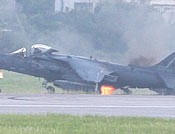
September 5, 2014 Ryukyu Shimpo
Around 5:12 p.m.on September 4, the United States Marine Corps’ AV-8B Harrier II caught fire near one of its tires after an emergency landing. The aircraft is normally stationed at the Marine Corps Air Station Cherry Point but was temporarily relocated to Kadena Air Base for training.
According to the Okinawa Prefectural Government (OPG), which inquired about the accident to the Okinawa Defense Bureau, friction that occurred when the aircraft landed caused it to catch fire.
Kadena Town Mayor Hiroshi Toma said, “The AV-8B Harrier II has burst into flames on the runway before. There is a possibility the aircraft has deficiencies. I would like the U.S.military to remove it immediately.”
The Three Municipalities Liaison Council consisting of the mayors of Okinawa City, Kadena and Chatan Town near the Kadena Air Base said that it is considering protesting against the accident.
According to witnesses of the accident, the AV-8B Harrier II took off the runway on the northern side around 5:08 p.m., and circled towards Yomitan area. The aircraft then landed on the runway faster than usual.
It moved to the taxiway, and the pilot turned off the engine. Soon after that, the aircraft caught fire near one of its tires. Emergency vehicles discharged water on it and the pilot escaped soon after the fire. Around 9:00p.m., the aircraft was towed toward a hangar.
Immediately after the fire, another three AV-8B Harrier II left the base for training.
In the morning of September 4, an F-15 Eagle belonging to the base made an emergency stop soon after taking off. The U.S.military closed the runway on the southern side for several hours.
The Kadena Town Assembly held a special meeting on U.S. military base affairs on August 5.
The assembly members talked about the accident and how to deal with the risk of continuing accidents involving the U.S.military aircraft such as F-15 Eagle crashes in the United States.
A spokesperson of the Military Base Affairs Division of the OPG said, “One wrong move and it could be a serious accident. We would like the U.S.military to follow all the safety rules.”
A representative of the U.S.Marine Corps stated that the AV-8B Harrier II carried out a preventive landing because warning lights were flashing. She said hot brakes caused the fire, and that no injuries were reported. According to them, damages to the airplane were minimal.
(English translation by T&CT)
Go to Japanese
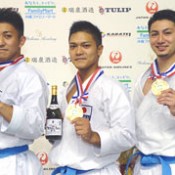
September 1, 2014 Taichi Hirayasu of Ryukyu Shimpo
The final competition of the Karate 1 Premier League was held on August 31 at the Okinawa Prefectural Budokan in Naha City. In the final of the Kata Team Division, Okinawa team, including Ryo Kyuna (Ryueiryu and Kobudo-ryuhokai), Arata Kinjo (Ryueiryu and Kobudo-ryuhokai) and Takuya Uemura (Okinawa International University), won the championship title, defeating the opponent by 4-1. Kyuna captured two crowns, with his title in the men’s Kata Individual Division. This is the third time they have captured the title in the Kata Team Division of the Premier League, which follows the 2013 tournament in Germany and the 2012 in Turkey.
Kyuna said, “We could perform well as a result of the training and this led to the victory.” This is the first time Okinawa has hosted the Karate 1 Premier League. Many Karate men and women from abroad took part in the tournament.
The three martial artists defeated strong opponents by focusing on a single purpose.
The biggest applause was roused by Ryo kyuna, Arata Kinjo and Takuya Uemura when they appeared on the tatami mat. They performed with their best efforts in the final challenge, creating a memorable scene for all the spectators at the tournament held in Okinawa. Despite aiming for the very top, they tried to just enjoy and do the performance as usual.
Their opponents in the final match were Japan’s representatives, who have always won the world championship. Kinjo said, “We have never won against them until now.” Kyuna recalled, “We have focused on our performance without being thrown by the play of the opponents.” The Okinawa team performed the Kata Annan employed by their sensei Tsuguo Sakumoto when he won the world title.
Uemura said, “‘We have done this with perfect teamwork.” They executed their movements in perfect order. With strong presentation, and technique in a continuous flow and high speed, their performance captivated the spectators. They also performed kata bunkai, in which they showed fighting techniques. The viewers that filled the venue were excited to see their powerful performance. “This was a victory that we won together with everyone who cheered for us,” Kinjo said with delighted satisfaction.
“I am a lot more glad to have won the title of the team division than that of the individual division because we have done so much together,” Kyuna said with smile.
“We have extended ourselves and done well. We thank Sakumoto sensei so much for his guidance,” Uemura said with a sense of accomplishment. They set to win the World Championship as the next goal. “We will continue our hard training to catch up with Sakumoto sensei,” they said.
(English translation by T&CT)
Go to Japanese
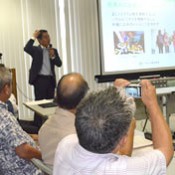
August 29, 2014 Ryukyu Shimpo
On August 28, the Okinawa Products Associated Co. Ltd launched the Okinawa Halal Chamber to expand business for Okinawan products in the Islamic market in Southeast Asia. The Chamber will hold test marketing of Okinawan products in Malaysia in November and in Singapore in January 2015.
The Chamber consists of 19 Okinawan companies and supporting groups made up of food manufacturers. It plans to increase its membership. The board members will be selected at the next meeting in October. The head office is located at the Overseas Project Division of the Okinawa Products Associated Co.
During the first year of the project, the Chamber will conduct research of Islamic markets and conduct study sessions to get certification as a producer of Halal food (cooked and processed according to the law of Islam). Focusing on markets in Malaysia and Singapore, the Chamber will develop “non-pork, non-alcohol” products. The Chamber is planning to sell products from the member companies that get certification as Halal food producers.
On August 28, the Chamber held its first meeting at the Okinawa Industry Support Center. Akmal Abu Hassan of Malaysia Halal Corporation Co., Ltd. gave a lecture on the theme of “tips for business expansion in Islamic market.” Akmal emphasized the importance of understanding Muslim and Halal business.
(English translation by T&CT and Megumi Chibana)
Go to Japanese
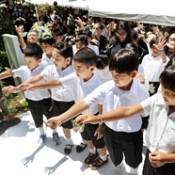
August 23, 2014 Ryukyu Shimpo
August 22 marked 70 years since the evacuation ship Tsushima-Maru carrying many school children was sunk by a U.S. submarine. At a memorial service held at the Kozakura-no-To monument in Wakasa, Naha, about 450 people, including survivors and bereaved families took part. They released rice paper butterflies into the sky as they prayed for the victims and for peace.
In his memorial address, Masakatsu Takara, president of the Tsushima-Maru Memorial Foundation referred to the fact the number of the living survivors and bereaved families has been decreasing from year to year.
He talked about plans to use movies and teaching training to pass on the tragedy to future generations. Takara said, “We would like to further develop the Tsushima-maru Memorial Museum.”
In her speech, the chairwoman of Bereaved Families of Okinawa Prefecture War Dead Joint Association Naeko Teruya said, “The emotional wounds of the bereaved families remain unhealed. We would like to do our best to not let horrible wars ever occur again.”
Members of a choir, formed by pupils belonging to the elementary schools which had victims of the tragedy, sang songs such as Song of Kozakura-no-To to pray for peace.
Eighty-one-year-old Hisako Kishimoto, who was evacuated to Kagoshima Prefecture when the tragedy happened, expressed sympathy to the victims and took part in the memorial service. She said, “Before evacuating Miyazaki Prefecture, I saw children wrapped in bandages. Later, I knew that they were survivors of the tragedy.” Kishimoto continued, “I want to pray for the repose of the souls of those who were in my generation and lost their lives in the tragedy.”
Eighty-six-year-old Shosuke Shiroma, who lost his sister Takako in the tragedy, visited the memorial service and museum with his eldest daughter Kaori Nakamatsu and grandchild. Shiroma said, “After my sister died, my mother was standing in front of a family altar, crying. I guess that she felt pain and couldn’t express her feeling to anybody because my father was already dead.” Nakamatsu who attended the memorial service for the first time, said, “I would like to continue to take part in the service to pass on the tragedy to future generations on behalf of my father.”
On August 21, 1944, an unmarked Japanese passenger-cargo ship carrying hundreds of schoolchildren Tsushima-Maru left Naha Port for Nagasaki Prefecture. At 10:23 p.m. on August 22, the submarine USS Bowfin sank the ship, killing 1,485 people (names identified).
(English translation by T&CT)
Go to Japanese
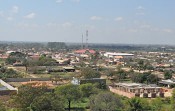
August 25, 2014 Masaaki Umeda of the Ryukyu Shimpo
This year marks the 60th year since Okinawans emigrated to Bolivia under the immigration plan by the Ryukyu Government. After 1954, 3,385 Okinawan people emigrated to Bolivia on 19 occasions over 10 years. The migrants established a community by reclaiming dense forest.
About 800 Okinawan Bolivians currently live in three transmigration sites. Despite the difficulties the pioneers experienced, Okinawan migrants succeeded in large-scale mechanized farming. The Bolivian government approved the farm area as “capital of wheat,” which is known for its high standard in the country.

The statue-tributes to Okinawan migrants who established their community at Colonia Okinawa. At the Okinawa Association of Bolivia site on August 10.
From August 17 to 18, a harvest festival and a ceremony for the 60th anniversary of the immigration were held in Bolivia.
The descendants of Okinawan people who emigrated to Bolivia and then moved to other South American countries, and a visiting group from Okinawa took part in the ceremony.
With other Bolivians living in the settlement area attending, all the community members pledged to encourage development in the Okinawa Bolivian community.
Ryukyu Shimpo presents a photo gallery of the settlement sites .
(English translation by T&CT)
Go to Japanese

Yukifumi Nakamura, chairperson of the Okinawa Association of Bolivia explained about the use of farm equipment by Okinawa migrants to Okinawa Vice Governor Kurayoshi Takara (left) at the Okinawa Bolivia Historical Museum on August 16.

Silos owned by the Cooperativa Agropecuaria Integral Colonias Okinawa (CAICO). Each can store about 15,000 tons of grains. The association owns 12 buildings and plans to increase this number. At the first settlement site on August 11.

The young people from Okinawa and Colonia Okinawa who took part in the Youth Future Conference which was held by the Worldwide Youth Uchinanchu Joint Association. They pledged to keep interacting with each other. At the First Japanese Bolivian Elementary School on August 15.

Eisa event held at a harvest festival. Many Okinawan Bolivians, other Bolivians and children took part. At the First Area Hall in Colonia Okinawa on August 16.

Okinawan Bolivians sang Shimauta at the First Area Hall in Colonia Okinawa on August 16.

At the end of the ceremony, the participants danced the kachashi. In Colonia Okinawa on August 17.
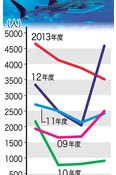
August 23, 2014 Ryukyu Shimpo
The number of foreign tourists visiting the Okinawa Churaumi Aquarium has been steadily increasing.
According to the aquarium, the number was 7,770 in the 2009 fiscal year. However, it amounted to about 16,160 in 2013, increasing by roughly double over five years.
While the ratio of foreign visitors to domestic ones was 6.8 percent in fiscal 2009, it increased to 11.9 percent in 2013. The largest number of foreign visitors came from Taiwan, followed by Hong Kong and South Korea.
The aquarium began surveys on foreign visitors in 2009. It carried them out four times a year and took four days for each survey.
A lower yen and the expansion of international air routes contributed to the increase in the number of the foreign tourists to Okinawa, which led to an increase in the number of foreign visitors to the aquarium.
The overall number of visitors to the aquarium, including foreign tourists was 114,110 in fiscal 2009. The figure amounted to 136,120 in fiscal 2013, increasing by 19.3 percent over five years.
The head of the aquarium Hirokazu Miyahara said, “Although we are handing out multilingual brochures to the foreign visitors, this is not enough. We would like to try various approaches, such as recruiting people who speak foreign languages.”
(English translation by T&CT)
Go to Japanese
August 22, 2014 Ryukyu Shimpo
Mandarin Airlines submitted an application to the Ministry of Land, Infrastructure, Transport and Tourism to offer Naha-Gaoxiong flights regularly from October 26, 2014. China Airlines, a parent company of Mandarin Airlines, also decided to offer a Naha-Taipei flight twice a day due to an anticipated increase in tourist demand from Taiwan during the winter period, until March 28, 2015 from October 26, 2014.
Mandarin Airlines will use Embraer 190 with 104 seats for its Naha-Gaoxiong charter flights, five times a week. However, the flights will be reduced to four flights a week during the winter period. China Airlines offers 11 flights a week during the winter period. According to the China Airlines Okinawa branch, the Naha-Gaoxiong and Naha-Taichung routes are now running at 70 percent capacity. The Taipei line is expected to be about 80 percent capacity.
Sophie Teng, the manager of the China Airlines Okinawa branch, said, “We decided to offer flights from the southern part of Taiwan regularly due to high tourist demand in Taiwan. To fully leverage the new service, we hope people from Okinawa will visit Taiwan as well.”
(English translation by T&CT and Hitomi Shinzato)
Go to Japanese
August 25, 2014 Ryukyu Shimpo
The weather cleared up in the Okinawa region due to an anticyclone on August 24. However, it rained heavily in some areas because the state of the atmosphere was unstable. The temperature hit 33.7 degrees in Yonaguni island. It was a tropical day in the Okinawa region .
A family played in the water and cooled themselves at Nishizakishin Water Park in Itoman.
Five-year-old Komaki Toma and her family members splashed water on one another. Toma said, “Water feels real good. I want to play more.”
(English translation by T&CT)
Go to Japanese
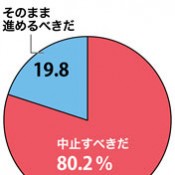
August 26, 2014 Ryukyu Shimpo
Ryukyu Shimpo and Okinawa Television Broadcasting (OTV) carried out a telephone poll jointly on August 23 and 24 referring to the seabed drilling survey in Henoko, Nago. The Henoko bay area is the planned reclamation site for U.S. Marine Corps Air Station Futenma. The poll found 80. 2 percent of residents favored cessation of the relocation work. Only 19. 8 percent of respondents said that the work should continue as is.
The poll revealed 81.5 percent of residents do not support the Abe administration’s attitude, while 18.6 percent support it. This figure highlights an increasing backlash against the Abe administration, which forced the relocation work amid Nago City’s opposition to it.
To the question of whether Okinawa Governor Hirokazu Nakaima should respond to this issue, 53. 8 percent suggested that the governor should cancel his approval of the landfill, and that he should ask for the government to discourage the construction plan itself. Seventy-four percent did not favor the governor’s approval of the landfill, including the people who responded that the governor should not cooperate with the government on this issue and should seek the government to halt the work at least. This suggests the citizens’ strong criticism against the governor’s approval of the landfill.
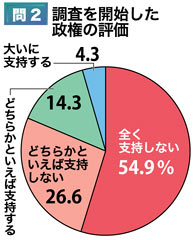
Question 2: What do you think about the Abe administration that initiated the boring survey? The red color shows “I do not support it at all," the pink “I generally do not support it,” the green “I fully support," and the blue "I generally support it.”
With regard to the solution to the Futenma issue, 79.7 percent of respondents sought “unconditional closure and removal of the Futenma base,” or relocation of the base outside Okinawa in Japan or abroad. Only 10 percent favor the Henoko relocation. A mere 4.6 per cent of respondents support the relocation of the base to a site other than Henoko within the prefecture.
In response to the question, “What is the most important issue for voters about to choose between candidates for governor at the gubernatorial election on November 16?”, the largest majority of respondents, 34. 3 percent, selected base issues such as the Futenma relocation and return of it”. This was followed by “employment policy and economic development”(24.4 percent) and “medical, welfare and education issues” (19.3 percent).
Regarding a boring survey of the seafloor in preparation for landfill work necessary to build the air base, 87.7 percent of people in their 60s responded that the boring survey should be stopped. This stance was found in high percentages among middle-aged and elderly respondents. 72. 9 percent of people in their 20s also responded that the boring survey should be stopped.
About 85.3 percent of women and 73.9 percent of men wanted the boring survey to stop. In terms of occupation categories, 90.4 percent of full-time housewives responded that the boring survey should be stopped. This attitude was also revealed in a high percentage among part-time workers and freelance professions. A little less than 30 percent of clerical workers, civil servants, agricultural workers, and forestry and fisheries workers, indicated that they thought the boring survey should proceed. Though still the minority, this percentage is relatively high compared to other occupations.
(English translation by T&CT)
Go to Japanese
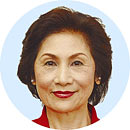
August 21, 2014 Ryukyu Shimpo
On August 20, Keiko Itokazu, a member of the Upper House and leader of the Okinawa Social Mass Party, took part in a UN Committee on the Elimination of Racial Discrimination held at Geneva in Switzerland. She called for the immediate cessation of the construction of a new base in Henoko, Nago, and helipads in Takae, Higashi, which are partly a relocation of U.S. Marine Corps Air Station Futenma. Itokazu presented in traditional Okinawan dress and reported on the current situation at Henoko, saying; “The Japanese government and the Okinawa Defense Bureau are continuing to use private security companies, riot police, and the coast-guard to suppress the many citizens who are raising their voices in protest.” She asserted the forcible construction of military bases on Okinawa is “a deliberate ignoring of human rights and discrimination against the people of Ryukyu.” This is the first time an elected congresswoman from Okinawa has made a “direct appeal” to the United Nations.
Upon being given the chance to speak by the Committee, Itokazu appealed for the UN’s involvement in what she raised as urgent issues. The four issues were: The protection of the will and dignity of the Ryukyuan people; Ending the crackdown on residents protesting for the revocation of the plan to build a new military base in Henoko; The immediate closure and withdrawal of Futenma Air Station; and the immediate termination and revocation of the plan to build helipads in Takae.
A committee member asked how Okinawans are different from the Japanese in language and culture in response to claims by the Japanese government that the people of Okinawa and the Japanese are the same. Itokazu answered by pointing out that the Ryukyus have had 500 years of history as an independent nation, and that the Ryukyuan language is recognized as a language in its own right by UNESCO.
(English translation by T&CT and Lima Tokumori)
Go to Japanese

















 Webcam(Kokusai Street)
Webcam(Kokusai Street)


